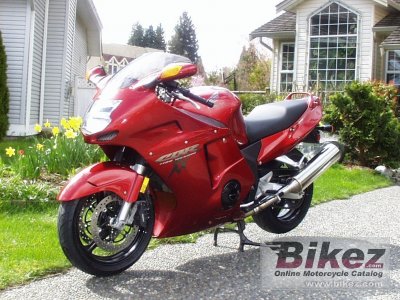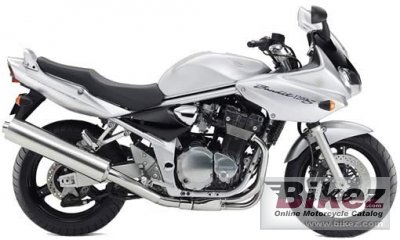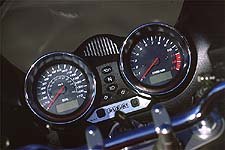2003 Yamaha FJR1300 vs. Honda ST1300
Source:http://www.ridermagazine.com/output.cfm?id=142849
| 2003 Yamaha FJR1300 vs. Honda ST1300 | ||||||||||||||||||
| Battle of the light-heavyweights. | ||||||||||||||||||
| Bill Stermer | ||||||||||||||||||
| Rider Report | ||||||||||||||||||
 Email this article to a friend! Email this article to a friend! | ||||||||||||||||||
Going toe-to-toe here are two new models, each with a proud lineage. Each wants the title, and carries a load of the good technical stuff. They float like butterflies, sting like B-52s. Both are at the top of their game. The 2003 Honda ST1300 ABS and Yamaha FJR1300 utilize different styles, like the classic boxer-vs.-puncher bout. The ABS-model Honda enters this fray wielding technology and tonnage to spare. Its focus is on luxurious long-distance comfort through adjustable rider seating, a huge range of windshield adjustability, anti-lock linked braking and suspension quality. Yamaha’s strategy is a hard-edged road burner with a less-is-more philosophy: more brute power, but less in terms of weight, price and level of luxury. The more Spartan Yamaha’s only counter to the above is an electric windshield, albeit one that offers much less range and protection. We’ll provide the front-row seat as to which bike works best for your needs.
The Honda ST1300 is an update of the ST1100 that first appeared as a 1990 model and, with revisions, lasted through 2002. It was known for its smooth power, supple suspension, major avoirdupois, 7.4-gallon fuel tank and high gearing. Though still powered by a longitudinal, liquid-cooled DOHC, four-valve V-4, the new ST1300 now displaces 1,261cc with a 10.8:1 compression ratio, and utilizes PGM fuel injection. The Yamaha FJR1300 is an update of the line of big air-cooled, four-cylinder road burners, the FJ1100 that first appeared in 1984, and the 1986 FJ1200 that lasted through 1993. The new 1,298cc model retains the in-line, transverse, DOHC four-cylinder layout with four-valve heads, but is now an all-new engine with liquid cooling and Mitsubishi electronic fuel injection. Both utilize shaft final drive. Price
Performance Start them up and each four-cylinder engine is a marvel of smoothness and power. Out on the road the Yamaha feels aggressive, like a big-inch supersport that grew a fairing and bags. The Honda, by contrast, seems designed from the beginning as a sport tourer. Its pleasing mechanical purr becomes a snarl in the upper rpm ranges. While the Yamaha peaks at 124.5 rear-wheel horsepower at 7,850 rpm and puts out 90.1 pounds-feet of torque at 6,700, the Honda cranks out 111.3 peak rear-wheel horsepower at 7,700 rpm, and makes 83.6 pounds-feet of torque at 6,100 rpm. Both have steep horsepower graph lines and hugely broad powerbands, but the Yamaha’s torque curve has some rolling hills in it, while the Honda’s is as flat as Nebraska. Roll-ons are a good measure of how midrange power interacts with gear ratios and weight. The lighter, more powerful FJR pulls away smartly from the Honda during third-gear roll-ons at 3,000 and 4,000 rpm. At 5,000 rpm, however, the Honda is coming into its power range and hangs much closer. In fifth-gear roll-ons, again, the FJR leaves the ST flat. While the FJR, with its dual gear-driven counterbalancers, is acceptably smooth through most of its rev range, one high-speed romp left a tester with numb hands. The Honda, also with dual counterbalancers and slightly higher gearing, was always a gentleman in terms of engine vibes. However, excessive driveline lash and engine heat on the rider’s legs were annoyances on the Honda, while the Yamaha’s five-speed shifts well, the Honda’s shifts superbly. Wind Protection The first requisite of a sport tourer is long-distance comfort, a balance of wind protection, smoothness, ergo-nomics and seating comfort. Both of these machines offer good-sized fairings with adjustable windshields. The Yamaha’s is electrically operated by means of a thumb-operated pushbutton over a range of 4.6 inches vertically, and a 20-degree angle. While it offers adequate protection, we recommend the optional shield that is 4 inches taller and 2 wider. The standard-model Honda’s shield is fixed in place, but offers 2.3 inches of manual adjustment by repositioning the shield on its mounting brackets. The shield on the ABS-model Honda is electrically adjustable up to 7.4 inches vertically and a 13-degree angle, and it can also be manually repositioned. As it rises from the low position, the wind at first comes over the top of the shield, then around the sides where it pushes the rider forward. The wind tends to be noisy until the shield’s top is at or near eye level, where the ST1300 rider sits comfortably in a pocket of still air. With its greater height and adjustability range, and because it sits closer to the rider, the Honda’s shield offers greater wind protection. Seating Comfort A multiadjustable rider’s portion of the seat gives the Honda rider not only three heights within a range of 1.2 inches vertically, but it also slides 1 inch fore-and-aft and adjusts for slant. We average-sized riders were able to find a very suitable position. The Yamaha, though its seat is non-adjustable, was very satisfactory to our staff, the right blend of cush with firmness, and with a fixed but nicely low height that makes the bike easy to paddle around. Saddlebags Both bikes come standard with hard-shell, lockable, easily removable saddlebags, and both look better with their bags in place. Each bag will hold a full-face helmet. Outwardly, the Honda’s bags appear to be larger and more fully integrated into the bodywork. However, what appears to be extra room toward the front is really quite shallow and of little use. The Honda’s also lack hold-down straps. The Yamaha’s bags appear to be more stuck-on than integrated, yet hold approximately the same amount as the Honda’s and utilize convenient hold-down straps. The Honda’s remove and attach slightly more easily, and their latches work better. The Yamaha’s boxlike shape make them easier to pack. Each has a luggage rack, but only Yamaha offers an accessory top trunk. Suspension/Brakes These big bikes just beg to be ridden fast, and for that you’re going to want a capable set of suspenders. The FJR’s fully adjustable 48mm fork is certainly compliant. Its single rear shock offers two-position spring preload, and is adjustable for rebound damping. At very aggressive speeds, you may wish for more firmness and less fork dive. Still, for 95 percent of your sport-touring needs, it’s right where you want it. The ST’s single rear shock is adjustable for spring preload and rebound damping, and offers a very solid feel with good control and damping. Despite its non-adjustable, 45mm cartridge fork, the ST delivers that rare plush/controlled feel, and throws in remarkable anti-dive qualities to boot. The latter is partly because of the Honda’s linked braking system; using either the front lever or the rear pedal activates the stoppers at both ends. Through a proportional control valve, the majority of braking force is delivered to whichever brake was actuated with more force. A delay valve in the fork slows initial braking response to minimize fork dive, and it all works very well. Our test ST was equipped with anti-lock brakes, which of course can be paint-savers (or better) under tricky traction conditions. It provided quick, short, secure stops on a variety of surfaces. The Yamaha’s brakes, though off the R1 sportbike, did not offer quite the bite we wished, and the rear locked too easily. Handling Perhaps the most remarkable difference between these bikes is in their handling. The FJR, with its 26 degrees of rake, 4.3 inches of trail and 60.6-inch wheelbase, turns by means of aggressive inputs from the rider’s upper body and pressure on the handlebars. It loves fast sweepers but demands work in tight turns. The Honda, by contrast, combines its shorter 58.7-inch wheelbase with a 26-degree rake and 3.9 inches of trail. These, along with the new lower, more forward-weight bias and tire choice, result in much more responsive, relatively low-effort steering despite the bike being 81 pounds heavier than the Yamaha. With a swing of the rider’s hips the Honda delights in tight turns. Passenger Accommodations A major consideration for couples is how well a prospective ride treats its co-rider. A passenger aboard the Yamaha finds a relatively short rear seat that tucks him or her into the rider and forces the knees out to the sides. The seat is firm, and the windblast relatively unaffected by the position of the windscreen.
Range With these two silver bullets the lighter, more powerful Yamaha burned a gallon every 38.4 miles, while the porkier Honda offered 42.6 miles per gallon on the same ride. With its 6.6-gallon tank the Yamaha offers a very respectable range of 253 miles per tank. A 5.5-gallon conventional tank on the Honda, combined with another 2.2 gallons below the seat, delivers a remarkable range of 328 miles. That should be enough for anyone’s loneliest road. The Little Things Two small fairing compartments, one lockable, and a larger underseat area, allow the ST1300 rider to bring along perhaps two pairs of midweight gloves, a U-lock and some road food. It also offers hidden tipover bars, two helmet hooks, a 660-watt alternator and electric headlight adjuster—but no available trunk. The FJR1300 offers a U-lock/glove compartment, no helmet hooks and a 490-watt alternator. Both have centerstands and catalysts. According to their makers, the Yamaha meets U.S. and California 2006 emissions standards; the Honda meets 2008 standards.
It’s no cop-out to say that each of these bikes is a winner. Which you choose will depend upon your performance/luxury/price balance. If you invested heavily in dot.coms, Worldcom and Enron stocks, and are just scraping by, the Yamaha’s 20 percent price advantage makes it an easy call. It is also the slugger, the sportier of the two, and at 635 pounds wet weighs 81 pounds less than the 716-pound Honda. You can certainly feel that weight as you paddle around the parking lot, but in turns it’s less of a factor. If on the other hand you like sporty riding but have come to prefer it mixed with some degree of luxury, as long as you’re willing to pay the price to obtain it the Honda’s quick steering response more than makes up for the weight difference. With its better weather protection and well-controlled, squash-butt comfort, the Honda ST1300 is the finesse fighter. So what will it be, great performance with some luxury, or luxury with a good deal of performance? If your sport-touring preferences lean toward the former, and you like your bikes leaner, meaner and less expensive, remember these three little letters: FJR. Or if you can justify it, choose the Honda ST1300. Stay tuned for long-term reports on both bikes ASAP. 2003 Honda ST1300
Engine Type: Liquid-cooled, long. 90-degree V-4, DOHC, 4 vales per cyl. Displacement: 1,261cc Bore x Stroke: 78.0 x 66.0mm Transmission: 5-speed, hydraulically actuated wet clutch Final Drive: Shaft, 2.833:1 Wheelbase: 58.7 in. Rake/Trail: 26 degrees, 3.9 in. Seat Height: 30.5, 31.1 & 31.7 in. Wet Weight: 716 lbs. Fuel Capacity: 7.7 gals., warning light on last 1.2 gal. Average mpg: 42.6 2003 Yamaha FJR1300 Base Price: $11,499 Engine Type: Liquid-cooled, transverse in-line four, DOHC, 4 valves per cyl. Displacement: 1,298cc Bore x Stroke: 79.0 x 66.2mm Transmission: 5-speed, hydraulically actuated wet clutch Final Drive: Shaft, 2.773:1 Wheelbase: 60.6 in. Rake/Trail: 26 degrees/ 4.3 in. Seat Height: 31.7 in. Wet Weight: 635 lbs. Fuel Capacity: 6.6 gals., warning light on last 1.3 gal. Average mpg: 38.4 |
















